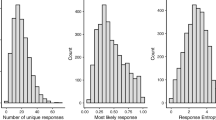Abstract
Sentence-completion norms for sentences using a multiple production measure are presented. A subset of these items were taken from the Bloom and Fischler (1980) sentence-completion norms in order to compare the Cloze measure with the present multiple production measure. For both measures, the sentence constraint correlated negatively with the number of responses generated across subjects. Although the Cloze measure and the multiple production measure were highly correlated, sentence predictability was higher when the multiple production measure was used. These sentence norms provide an alternative to norms derived using the Cloze procedure.
Similar content being viewed by others
References
Becker, C. A. (1980). Sentence context effects in visual word recognition: An analysis of semantic strategies.Memory & Cognition,8, 493–512.
Bloom, P. A., &Fischler, I. (1980). Completion norms for 329 sentence contexts.Memory & Cognition,8, 631–642.
Cole, R. A., &Perfetti, C. A. (1980). Listening for mispronunciations in a children’s story; The use of context by children and adults.Journal of Verbal Learning & Verbal Behavior,19, 297–315.
Eisenberg, P., &Becker, C. A. (1982). Semantic context effects in visual word recognition, sentence processing, and reading: Evidence for semantic strategies.Journal of Experimental Psychology: Human Perception & Performance,8, 739–756.
Fischler, I., &Bloom, P. A. (1979). Automatic and attentional processes m the effects of sentence contexts on word recognition.Journal of Verbal Learning & Verbal Behavior,18, 1–20.
Fischler, I., &Bloom, P. A. (1985). Effects of constraint and validity of sentence contexts on lexical decisions.Memory & Cognition,13, 128–139.
Goodman, K. S. (1970). Reading: A psycholinguistic guessing game. In H. Singer & K. Ruddell (Eds.),Theoretical models and processes of reading (2nd ed.). Newark, DE: International Reading Association.
Gough, P. B., Alford, J. A., &Holley-Wilcox, P. (1981). Words and contexts. In O. J. L. Tzeng & H. Singer (Eds.),Perception of print: Reading research in experimental psychology. Hillsdale, NJ: Erlbaum.
Kleiman, G. M. (1980). Sentence frame contexts and lexical decision: Sentence-acceptability and word-relatedness effects.Memory & Cognition,8, 336–344.
McClelland, J. L., &O’Regan, J. K. (1981). Expectations increase the benefit derived from parafoveal information in reading words aloud.Journal of Experimental Psychology: Human Perception & Performance,7, 634–644.
Schuberth, R. E., &Eimas, P. D. (1977). Effects of context on the classification of words and nonwords.Journal of Experimental Psychology: Human Perception & Performance,3, 27–36.
Schuberth, R. E., Spoehr, K. T., &Lane, D. M. (1981). Effects of stimulus and contextual information on the lexical decision process.Memory & Cognition,9, 68–77.
Schwanenflugel, P. J., &Shoben, E. J. (1983). Differential context effects in the comprehension of abstract and concrete verbal materials.Journal of Experimental Psychology: Learning, Memory, & Cognition,9, 82–102.
Schwanenflugel, P. J., &Shoben, E. J. (1985). The influence of sentence constraint on the scope of facilitation for upcoming words.Journal of Memory & Languages,24, 232–252.
Stanovich, K. E., &West, R. F. (1979). Mechanisms of sentence context effects m reading: Automatic activation and conscious attention.Memory & Cognition,7, 77–85.
Stanovich, K. E., &West, R. F. (1981). The effect of sentence context on ongoing word recognition.Journal of Experimental Psychology: Human Perception & Performance,7, 658–672.
Stanovich, K. E., &West, R. F. (1983). On priming by a sentence context.Journal of Experimental Psychology: General,112, 1–36.
West, R. F., &Stanovich, K. E. (1982). Source of inhibition in experiments on the effect of sentence context on word recognition.Journal of Experimental Psychology: Learning, Memory, & Cognition,8, 385–399.
Author information
Authors and Affiliations
Additional information
I thank Dawn Brennan and Leonie Escoffery for their help in data collection and tabulation.
Rights and permissions
About this article
Cite this article
Schwanenflugel, P.J. Completion norms for final words of sentences using a multiple production measure. Behavior Research Methods, Instruments, & Computers 18, 363–371 (1986). https://doi.org/10.3758/BF03204419
Received:
Accepted:
Published:
Issue Date:
DOI: https://doi.org/10.3758/BF03204419




